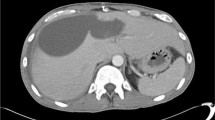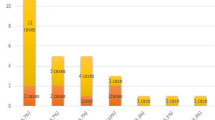Abstract
Purpose
Shotgun wounds pose diagnostic challenges due to variable fragment penetration and degradation of CT images. This study compared epidemiology and outcomes between shotgun wounds and gunshot wounds (GSWs), and defined the diagnostic capabilities of CT scan after shotgun wounds.
Methods
All patients presenting to our Level I trauma center after ballistic injury (01/2008–03/2017) were included. Study groups were defined by shotgun vs GSW. Demographics, clinical data, and outcomes were compared using univariate analysis. The diagnostic yield of CT scan after shotgun wounds was calculated.
Results
Of 3177 patients, 3126 (98%) were injured by GSWs and 51 (2%) by shotguns. Of the shotgun-injured patients, 5 (10%) had superficial wounds, 8 (16%) underwent emergency surgery, and 38 (74%) underwent CT scan [10 (26%) were then brought to OR and 28 (74%) were managed nonoperatively]. The sensitivity, specificity, PPV, and NPV of CT scan after shotgun wounds were 0.93, 0.96, 0.93, and 0.97. There was one false-negative CT scan, which missed a hollow viscus injury. There was one false-positive CT scan, which suggested a hollow viscus injury, although none was found on exploratory laparotomy. Patients injured by shotgun required fewer cavitary explorations (25% vs 59%, p = 0.006) but more soft tissue (21% vs 8%, p = 0.013) and extremity vascular surgeries (86% vs 9%, p < 0.001) than GSW-injured patients.
Conclusions
Shotgun injuries are far less frequent than GSWs but generally follow the same diagnostic and therapeutic considerations. Clinicians must be aware of the pitfalls of CT scanning after shotgun injuries, which can be falsely positive or falsely negative. A high index of suspicion for injury and a period of observation after negative CT scan may, therefore, be prudent.

Similar content being viewed by others
References
Rhee PM, Moore EE, Joseph B, Tang A, Pandit V, Vercruysse G. Gunshot wounds: a review of ballistics, bullets, weapons, and myths. J Trauma. 2016;80(6):853–67.
Dozier KC, Miranda MA, Kwan RO, Cureton EL, Sadjadi J, Victorino GP. Despite the increasing use of nonoperative management of firearm trauma, shotgun injuries still require aggressive operative management. J Surg Res. 2009;156:173–6.
Velmahos GC, Safaoui M, Demetriades D. Management of shotgun wounds: Do we need classification systems? Int Surg. 1999;84(2):99–104.
Cairns BA, Oller DW, Meyer AA, Napolitano L, Rutledge R, Baker CC. Management and outcome of abdominal shotgun wounds. Ann Surg. 1995;221(3):272–7.
Hafertepen SC, Davis JW, Townsend RN, Sue LP, Kaups KL, Cagle KM. Myths and misinformation about gunshot wounds may adversely affect proper treatment. World J Surg. 2015;39:1840–7.
Carrick MM, Morrison CA, Alexis DJ, Feanny MA, Pham HQ, Welsh FJ, Norman MA, Scott BG. Thoracoabdominal shotgun wounds: an evaluation of factors associated with the need for surgical intervention. Am J Surg. 2009;198:64–9.
Brakenridge SC, Nagy KK, Joseph KT, An GC, Bokhari F, Barrett J. Detection of intra-abdominal injury using diagnostic peritoneal lavage after shotgun wound to the Abdomen. J Trauma. 2003;54:329–31.
Hanna TN, Shuaib W, Han T, Mehta A, Khosa F. Firearms, bullets, and wound ballistics: an Imaging primer. Int J Care Injured. 2015;46:1186–96.
Funding
No funding was received for this study.
Author information
Authors and Affiliations
Corresponding author
Ethics declarations
Conflict of interest
Authors Schellenberg, Inaba, Heindel, Forestiere, Clark, Matsushima, Lam, and Demetriades declare that they have no conflict of interest.
Ethical approval
All procedures performed in this retrospective observational study involving human participants were in accordance with the ethical standards of the Institutional Review Board of the University of California (HS-17-00331) and with the 1964 Helsinki declaration and its later amendments or comparable ethical standards.
Informed consent
This study received a waiver for informed consent by the Institutional Review Board of the University of Southern California (HS-17-00331).
Rights and permissions
About this article
Cite this article
Schellenberg, M., Inaba, K., Heindel, P. et al. The diagnostic dilemma of shotgun injuries. Eur J Trauma Emerg Surg 46, 1351–1356 (2020). https://doi.org/10.1007/s00068-019-01168-4
Received:
Accepted:
Published:
Issue Date:
DOI: https://doi.org/10.1007/s00068-019-01168-4




